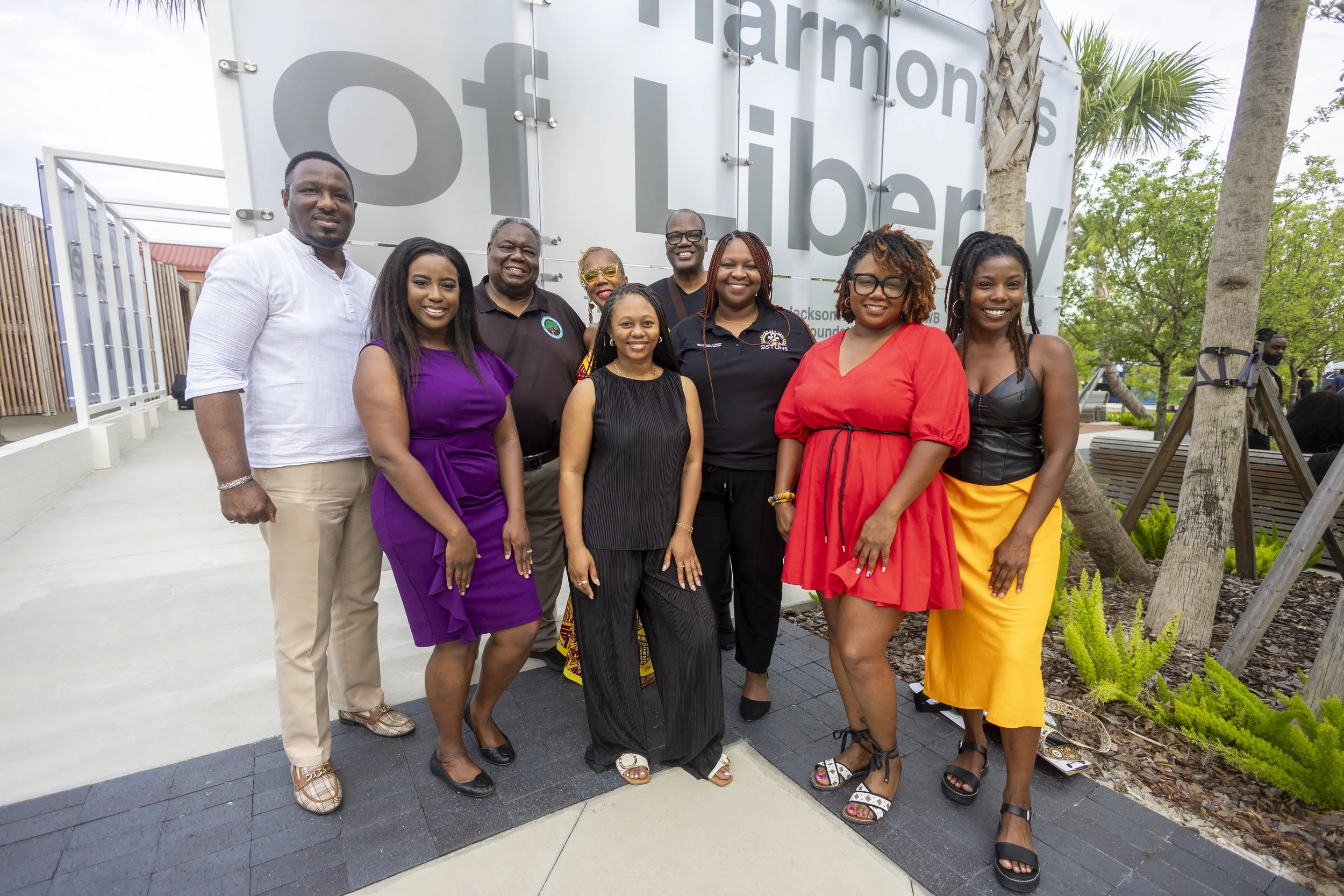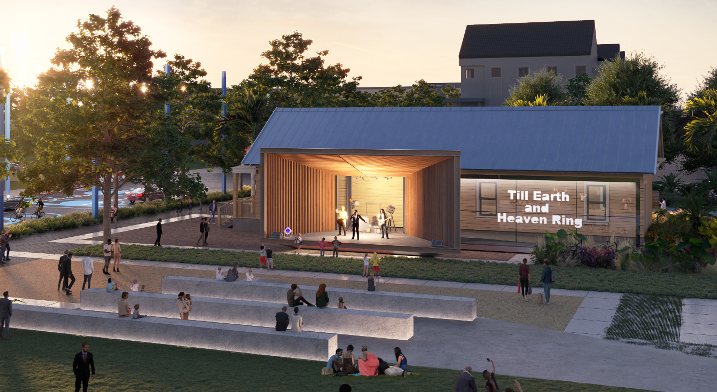
Lift Ev'ry Voice and Sing Park is a City of Jacksonville public park that incorporates elements of the Johnson brothers’ and LaVilla’s cultural and built history while making space for a more inclusive future. The Park was designed by world-renowned MacArthur Foundation “Genius Grant” recipient Walter Hood.
About the Park
Lift Evr’y Voice and Sing Park commemorates the Black National Anthem, celebrating the heritage and success of the once-segregated La Villa neighborhood in Jacksonville, and create a new park for the everyday and mundane, as well as community gatherings, events, and celebrations. It offers a beautifully landscaped area for community members to come together to celebrate, honor Jacksonville history and create new memories for generations to come. The park has been thoughtfully designed to honor the contributions of the Johnson brothers, while encouraging today’s artists and Jacksonville residents to leave their own lasting legacy.
Lift Ev’ry Voice and Sing Park was designed by Hood Design Studio, a public art and landscape architecture office based in Oakland, California. Hood Design principal architect and urban landscape designer Walter Hood was born and raised in Charlotte, rooted in the Southern experience. He has designed numerous projects that are a testament to the history and resilience of African Americans in the United States, including the International African American Museum in Charleston, SC, which was recently named “Project of the Year” by The Architect’s Newspaper. Walter is also a Professor and Chair of the Landscape Architecture and Environmental Planning Department at the University of California, Berkeley. He is a 2019 MacArthur Fellow, was recently elected to the American Academy of Arts and Letters and honored as WSJ Magazine’s Innovator of the Year.
Amenities at a glance:
The Vibrant Places Collective
The Vibrant Places Collective is a community-led group that curates exciting, inclusive programming every week at Lift Ev’ry Voice and Sing Park in the historic LaVilla neighborhood of Jacksonville, Florida.
Events are designed for ev’ryone, with a special focus on welcoming those who live, work, and play in LaVilla–including the neighbors and families who’ve called LaVilla home for generations. From yoga and line dancing to fitness classes and music festivals, all Collective-supported activities are free and open to the public.
The Collective is focused on honoring LaVilla’s history while celebrating its vibrant future. We do this by lifting up local entrepreneurs, educators, and activators who bring the Park’s vision to life.
The Collective is made up of historians, LaVilla natives and community leaders who have a connection to the park and the song. The group is facilitated by Black History Storyteller Carla Mechele.
The Vibrant Places Collective is:
Ms. Carol Alexander, local historian, curator of the A.L. Lewis Museum in Fernandina Beach; and owner of a cultural consulting firm;
Mr. Lloyd Washington, President of the Durkeeville Historical Society and the visionary behind the park becoming the gem that it is today;
Mariano Mendez, Owner of Mariano’s Custom Tailoring and a third generation LaVilla business owner;
Dr. Nadine Ebri, an educator who went viral teaching students the anthem;
Terrance Patterson, founder of the Ritz Chamber Players, the only all black chamber music group in the world–birthed out of LaVilla;
Erin Kendrick, the designer of the historical markers at the Park;
Charmion Thrasher, who managed fabrication of the markers; and
Rhianna Scyster, our neighbor at Johnson Commons.









Walter Hood’s vision
The conceptual approach of the park begins by tracing the plots of the homes, businesses and yards that once existed here when La Villa was a thriving Black neighborhood. It is within this stretch of land that the Johnson Brothers’ home stood and where they grew up. These traces are interpreted as paved bands throughout the park, from which new gardens, lawns, and gathering spaces emerge.
The park is comprised of five main architectural elements:
The Emerald Trail & Lee Street
Running along the eastern edge of the park is the Emerald Trail, an urban scale, multi-use path that accommodates pedestrians and cyclists. Aligned with the Emerald Trail is Lee Street. These both make a direct connection to the historic train station, an important feature in the cultural landscape of La Villa and all other Southern cities to African Americans. This was a point of arrival; a point of departure. This makes the Lee Street/Emerald Trail crucial to the entry sequence to LEVS and presents an opportunity to celebrate the Park and Street as a gateway.
Gardens
Emerging from the frames are a series of connected, planted spaces, primarily located on the southern end of the park. The planting design draws inspiration from the beauty of the embowered, overgrown, vacant lot that is carefully cultivated by human touch. The gardens frame a series of “rooms” – places for solitude, daily life, and small gatherings. Located in the southeast corner of the garden is the sculpture “Calling It Done” by Brian Owens.
“The Megaphone” Shotgun House and Stage
The centerpoint of the park sits a restored, historic La Villa home – a vessel of the past – the only vestige of African American domestic memory in La Villa. To reference the intention to protect this cultural history, three glass walls surround the house, sealing the memory in, while also providing a canvas for quotes and imagery.
Projecting from the side of the shotgun house is a stage that allows for a variety of performances or simply sitting on the porch – part of everyday life. This structure, combined with the House comprises The Megaphone: broadcasting the stories of the lives of those who once lived in this place.
Lifted Lawn
Facing the stage and shotgun is the lifted lawn, which rises up to have a dialogue with the Megaphone. This grassy area will be used just as much for the day-to-day of neighbors as it will for larger performances. From the apex of the lawn, one can look out over the park, surveying the land of the once-thriving community that stood here.
Lift Ev’ry Voice Plaza: Sculpture & Terrace
Acting as the gateway on the North of the Park, the Plaza is comprised of a palm grid, moveable tables and chairs, with a backdrop of a large sculpture, spelling out the words “Lift Ev’ry Voice and Sing.” This sculpture, made of tabby concrete – a shell-based, historic building material often made by enslaved people – literally supports the Lifted Lawn. Emanating from the base of the letters is a mist fountain – creating an ethereal fog from which the sculpture emerges. This fountain creates a dynamic environment that changes with the wind and times of day and seasons.
Thank you to our sponsors































